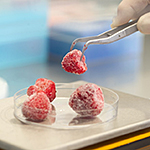You are here:
National Reference Laboratory for Foodborne Viruses

Several food types can be contaminated with pathogenic viruses. In this context, viruses causing diarrhea and hepatitis play a major role: norovirus and rotavirus can induce gastroenteritis and hepatitis A and E viruses can lead to inflammation of the liver. In the past, large disease outbreaks were caused by virus-contaminated food, e.g. by noro- and hepatitis A viruses in frozen berries or by norovirus-contaminated oysters. Noro-, rota- und hepatitis A viruses almost always enter the food chain through contamination with human excretions. In contrast, the hepatitis E virus can infect food-producing animals without these animals falling sick, and the virus can then be transmitted to humans via food products made from those animals.
The NRL for Foodborne Viruses carries out detections and characterizations of viruses in food in line with its legal tasks. In this context, sensitive and specific molecular biological techniques are mainly used. Because of the frequently low virus concentration and the presence of inhibitors in different food types that can impede virus nucleic acid detection using PCR, complex sample preparation techniques, which have to be adjusted to the analyzed food matrix, have often to be used. Reference materials are prepared for validation of the applied detection systems and laboratory proficiency tests are performed.
Main areas of the NRL for Foodborne Viruses:
- Molecular biological detection of noroviruses, rotaviruses, hepatitis A and E viruses as well as selected additional viruses in food
- Quantification of selected viruses in food
- Typing of selected viruses in food
- Preparation of reference materials for detection of viruses in food
- Organisation of laboratory proficiency testings
- Assumption of tasks within the framework of the Zoonoses Directive 2003/99/EC
- Advice and provision of scientific expertise
